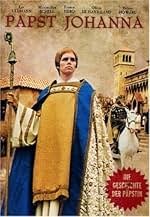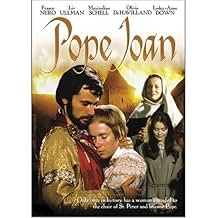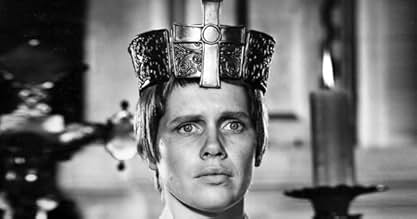Füge eine Handlung in deiner Sprache hinzuIn medieval Europe, a pious young woman becomes a scholar of theology, disguises herself as a man, rises through the Catholic Church hierarchy and is elected Pope.In medieval Europe, a pious young woman becomes a scholar of theology, disguises herself as a man, rises through the Catholic Church hierarchy and is elected Pope.In medieval Europe, a pious young woman becomes a scholar of theology, disguises herself as a man, rises through the Catholic Church hierarchy and is elected Pope.
Empfohlene Bewertungen
SHE
WHO WOULD BE POPE
I really enjoyed this film as a real aficionado of historical faction and legends. Movie buffs who yearn for renowned actors whose sex appeal and charisma fill up the screen, as soon as they appear without uttering a word, would also find this motion picture enthralling.
Franco Nero as Prince Louis, with blazing blue eyes brimming over in sensuality , becomes Emperor, conquering both Infidels and the Vatican. Although Jeremy Kemp, has a small role, whose pockmarked face, as handsome as it is rugged and scarred with life, makes him so credible as Joan's bible thumping father. Maximilian Schell, in his part as Brother Adrian is yet another from this large cast of famous faces who are a pleasure to watch as they captivate and capture the audience as they embrace their characters. The beautiful Lesley-Ann Downe although very young, is not as innocent or virtuous as she looks. No less are any of the remarkable cast such as the enchanting hero/heroine Liv Ullman, whose transformation from a nun to a priest is seamless, that makes the two hours of SHE..WHO WOULD BE POPE such compelling viewing.
Although the setting is in the Dark Ages, there is a lightness in the way the unpleasant events are portrayed that make the reality of the harshness of life in that time, acceptable to all, from rape, pillage, murder and forbidden love.
The Evangelicals haven't changed their book or mantras and the flowing robes and costumes of the clergy have all remained the same in authentically reproduced settings and lavish scenery. This story had to be retold in its original uncut form, sliding in and out of millennia, to fully understand how the world has turned despite that we, as individuals remain the same. The psychologist analysing a woman claiming a former life as Pope, ensures a multifaceted film that would appeal to a wide audience. SF
I really enjoyed this film as a real aficionado of historical faction and legends. Movie buffs who yearn for renowned actors whose sex appeal and charisma fill up the screen, as soon as they appear without uttering a word, would also find this motion picture enthralling.
Franco Nero as Prince Louis, with blazing blue eyes brimming over in sensuality , becomes Emperor, conquering both Infidels and the Vatican. Although Jeremy Kemp, has a small role, whose pockmarked face, as handsome as it is rugged and scarred with life, makes him so credible as Joan's bible thumping father. Maximilian Schell, in his part as Brother Adrian is yet another from this large cast of famous faces who are a pleasure to watch as they captivate and capture the audience as they embrace their characters. The beautiful Lesley-Ann Downe although very young, is not as innocent or virtuous as she looks. No less are any of the remarkable cast such as the enchanting hero/heroine Liv Ullman, whose transformation from a nun to a priest is seamless, that makes the two hours of SHE..WHO WOULD BE POPE such compelling viewing.
Although the setting is in the Dark Ages, there is a lightness in the way the unpleasant events are portrayed that make the reality of the harshness of life in that time, acceptable to all, from rape, pillage, murder and forbidden love.
The Evangelicals haven't changed their book or mantras and the flowing robes and costumes of the clergy have all remained the same in authentically reproduced settings and lavish scenery. This story had to be retold in its original uncut form, sliding in and out of millennia, to fully understand how the world has turned despite that we, as individuals remain the same. The psychologist analysing a woman claiming a former life as Pope, ensures a multifaceted film that would appeal to a wide audience. SF
There is a novel (Pope Joan/ I Papissa Iwanna) by Greek writer Emmanouil Roidis (1836-1904). It's written at the language of those times. Papissa means a woman Pope. Only now there are women in churches. Writer lived at Syros (Ermoupolis). There were many Catholics in that Greek island. This novel was not loved by church... And the writer was a blasphemy for the church exactly for this reason. The film's story is relative to this novel? John Briley knew Roidis' novel? IMDb's review don't say anything about this. If someone knows about it, please write... You can see about the novel and the writer in internet. There 're many relative sites. I 'm waiting for any answers about this. Thank you!
I saw the film on TV, quite by chance. I found the film gripping: the story, the atmosphere and the historical detail.
I have no religious interest, but it made me curious to find out more about 'pope Joan'. The film is a work of fiction based on a legend, with very little factual basis.
Nevertheless, one could really get a sense of life in those times (9th century Europe). Poverty, illiteracy, corruption. The place of women. The violence, that life was worth very little.
Sadly, I think much of the world is just like that today, so perhaps it is a little window on humanity.
I have no religious interest, but it made me curious to find out more about 'pope Joan'. The film is a work of fiction based on a legend, with very little factual basis.
Nevertheless, one could really get a sense of life in those times (9th century Europe). Poverty, illiteracy, corruption. The place of women. The violence, that life was worth very little.
Sadly, I think much of the world is just like that today, so perhaps it is a little window on humanity.
Costume drama based on popular legend about a 9th century nun who disguised herself as a man and--after some rather innocent deception--became Cardinal in Rome and later Pope before her secret was discovered. Panned by professional critics in 1972, "Pope Joan" was re-edited by nervous executives resulting in a picture that nobody was happy with. Still, despite the mangling, the performances come through, most especially Liv Ullmann's, excellent in the complex leading role. Supporting cast also fine, including Maximilian Schell (very sexy as a randy monk), Olivia de Havilland, Lesley-Anne Down, Patrick Magee, Franco Nero and Trevor Howard. Adequately filmed in London substituting for Italy, and worth a look for the curious. **1/2 from ****
The early 1970's was my favourite period in recent cinema history, classics such as Kubrick's Clockwork Orange, Skolimowsky's Deep End and Visconti's Death in Venice abound; but there are some, less than ringing endorsements of the era, this half-forgotten movie being one.
Liv Ullman, the embodiment of Scandinavian sang-froid, the epitome of ephemeral solemnity, plays Joan, a pious and youthful nun, who travels from a medieval convent, burnt down by Saxons, raping and pillaging, as if they misconstrued it for a set on a Ken Russell film, to Rome where disguised as a (rather attractive) young man, she wins her spurs, becomes a cardinal and eventually the first - and possibly last - female pope.
The trouble is, although Liv's performance is full of meaning and her fights against the alleged sin of lust, particularly enthralling, the editing, jumpiness and preposterousness of some scenes, leave an anxious viewer in need of redemption elsewhere.
True, it is interesting to see actors of the time - Lesley Anne Down, Maximillian Schell, Trevor Howard and Olivia de Havilland - giving robust performances, but a sandwich with an attractive filling is hardly worth eating if the bread is stale. And this is a stale mish mash, which ultimately fails to satisfy. It is a shame. The theme is interesting, whether the story is true or not. Given the current arguments amongst many religions on the role of women, it has significance for us in the 21st Century.
The scenery around Brasov, Romania, where it was filmed, which I visited post Ceausescu, is exemplary. Mind you, maybe the reason for the film's disjointed nature is just that - that the dictator, in his first flush of dictatorial youth, was in charge of production. There again, maybe Ceausescu was a woman. Now that would be a tale worth telling...
Liv Ullman, the embodiment of Scandinavian sang-froid, the epitome of ephemeral solemnity, plays Joan, a pious and youthful nun, who travels from a medieval convent, burnt down by Saxons, raping and pillaging, as if they misconstrued it for a set on a Ken Russell film, to Rome where disguised as a (rather attractive) young man, she wins her spurs, becomes a cardinal and eventually the first - and possibly last - female pope.
The trouble is, although Liv's performance is full of meaning and her fights against the alleged sin of lust, particularly enthralling, the editing, jumpiness and preposterousness of some scenes, leave an anxious viewer in need of redemption elsewhere.
True, it is interesting to see actors of the time - Lesley Anne Down, Maximillian Schell, Trevor Howard and Olivia de Havilland - giving robust performances, but a sandwich with an attractive filling is hardly worth eating if the bread is stale. And this is a stale mish mash, which ultimately fails to satisfy. It is a shame. The theme is interesting, whether the story is true or not. Given the current arguments amongst many religions on the role of women, it has significance for us in the 21st Century.
The scenery around Brasov, Romania, where it was filmed, which I visited post Ceausescu, is exemplary. Mind you, maybe the reason for the film's disjointed nature is just that - that the dictator, in his first flush of dictatorial youth, was in charge of production. There again, maybe Ceausescu was a woman. Now that would be a tale worth telling...
Wusstest du schon
- WissenswertesAfter a muted critical response, the film was severely re-edited. In its original incarnation, the film contained many flashbacks and flash-forwards, quite a progressive style for 1972. These were all removed to create a more linear story and the film was then released as "The Devil's Imposter". These changes were reinstated for a 2009 reissue.
- Alternative VersionenIn the version shown on BBC TV on 22nd October 2005, the 20th-century bookend scenes are cut, Keir Dullea and Robert Beatty do not appear, and the film ends abruptly with the crowd descending on Joan.
- VerbindungenFeatured in A Quiet Revolution (1972)
Top-Auswahl
Melde dich zum Bewerten an und greife auf die Watchlist für personalisierte Empfehlungen zu.
- How long is Pope Joan?Powered by Alexa
Details
- Erscheinungsdatum
- Herkunftsland
- Sprache
- Auch bekannt als
- The Devil's Imposter
- Drehorte
- Brasov, Rumänien(mountain top castle scenes)
- Produktionsfirmen
- Weitere beteiligte Unternehmen bei IMDbPro anzeigen
- Laufzeit2 Stunden 12 Minuten
- Sound-Mix
- Seitenverhältnis
- 2.35 : 1
Zu dieser Seite beitragen
Bearbeitung vorschlagen oder fehlenden Inhalt hinzufügen






























